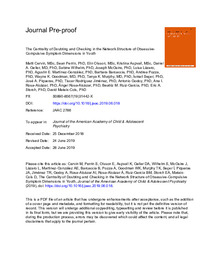Por favor, use este identificador para citar o enlazar este ítem:
https://hdl.handle.net/11000/36073Registro completo de metadatos
| Campo DC | Valor | Lengua/Idioma |
|---|---|---|
| dc.contributor.author | Cervin, Matti | - |
| dc.contributor.author | Perrin, Sean | - |
| dc.contributor.author | Olsson, Elin | - |
| dc.contributor.author | Aspvall, Kristina | - |
| dc.contributor.author | Piqueras, Jose A | - |
| dc.contributor.author | et al. | - |
| dc.contributor.other | Departamentos de la UMH::Psicología de la Salud | es_ES |
| dc.date.accessioned | 2025-03-24T08:10:10Z | - |
| dc.date.available | 2025-03-24T08:10:10Z | - |
| dc.date.created | 2020-07 | - |
| dc.identifier.citation | Journal of the American Academy of Child & Adolescent Psychiatry. 2020, 59(7): 880-889 | es_ES |
| dc.identifier.issn | 1527-5418 | - |
| dc.identifier.issn | 0890-8567 | - |
| dc.identifier.uri | https://hdl.handle.net/11000/36073 | - |
| dc.description.abstract | Objective. Obsessive-compulsive disorder (OCD) is a heterogeneous condition with wellestablished symptom dimensions across the lifespan. The objective of the present study was to use network analysis to investigate the internal structure and central features of these dimensions in unselected schoolchildren and in youth with OCD. Method. We estimated the network structure of OCD symptom dimensions in 6,991 schoolchildren and 704 youth diagnosed with OCD from 18 sites across six countries. All participants completed the Obsessive-Compulsive Inventory - Child Version. Results. In both the school-based and clinic-based samples, the OCD dimensions formed an interconnected network with doubting/checking emerging as a highly central node, i.e. exerting strong influence over other symptom dimensions in the network. The centrality of the doubting/checking dimension was consistent across countries, genders, age groups, clinical status, and tic disorder comorbidity. Network differences were observed for age and gender in the school-based but not the clinic-based samples. Conclusion. The centrality of doubting/checking in the network structure of childhood OCD adds to classic and recent conceptualizations of the disorder in which the important role of doubt in disorder severity and maintenance is highlighted. The present results suggest that doubting/checking is a potentially important target for further research into the etiology and treatment of childhood OCD. | es_ES |
| dc.format | application/pdf | es_ES |
| dc.format.extent | 34 | es_ES |
| dc.language.iso | eng | es_ES |
| dc.publisher | Elsevier | es_ES |
| dc.rights | info:eu-repo/semantics/openAccess | es_ES |
| dc.rights | Attribution-NonCommercial-NoDerivatives 4.0 Internacional | * |
| dc.rights.uri | http://creativecommons.org/licenses/by-nc-nd/4.0/ | * |
| dc.subject | obsessive-compulsive disorder | es_ES |
| dc.subject | network analysis | es_ES |
| dc.subject | dimensions | es_ES |
| dc.subject | children | es_ES |
| dc.subject | Obsessive Compulsive Inventory | es_ES |
| dc.subject.other | CDU::1 - Filosofía y psicología::159.9 - Psicología | es_ES |
| dc.title | The Centrality of Doubting and Checking in the Network Structure of ObsessiveCompulsive Symptom Dimensions in Youth | es_ES |
| dc.type | info:eu-repo/semantics/article | es_ES |
| dc.relation.publisherversion | https://doi.org/10.1016/j.jaac.2019.06.018 | es_ES |

Ver/Abrir:
2020_128_Investigacion_Publicaciones_The centrality of doubting.pdf
819 kB
Adobe PDF
Compartir:
 La licencia se describe como: Atribución-NonComercial-NoDerivada 4.0 Internacional.
La licencia se describe como: Atribución-NonComercial-NoDerivada 4.0 Internacional.
.png)